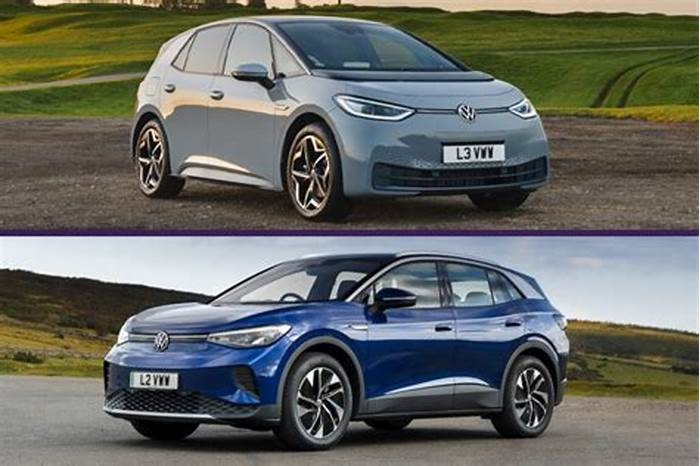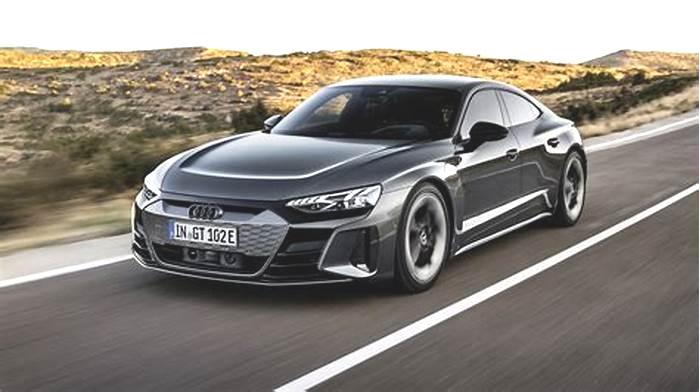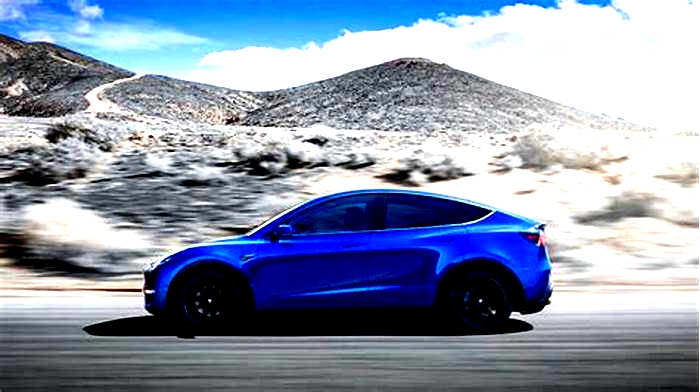Volkswagen ID 5 Sporty Electric Crossover with European Flair

2023 Volkswagen ID.5 review
Score breakdown
Safety, value and features
Things we like
- Unaggressive looks buck the industry trend
- It makes EV life simple to comprehend
- GTX version is quick and largely fun
Not so much
- It doesnt charge as quickly as some rivals
- Nor is it as charming
- VWs dropped the ball with ergonomics
The Volkswagen ID.5 isnt breaking any moulds, rather slotting into one of the most successful moulds right now: its one of those oh-so-fashionable crossover coupes but at least in the world of EVs they do bring aerodynamic benefits for a mite more range.
Like for like, an ID.5 will be several grand more than the VW ID.4 its based upon, though Australian prices are still to be confirmed.
People obviously love these things, otherwise, sensible brands like Skoda and Volvo wouldnt have jumped aboard the trend with the Enyaq Coupe and C40.
And the ID.5 appears to be a likeable take on the formula. if a little bland in some of its detailing. A softer-edged car makes a change from the industrys broader obsession with aesthetic aggression, though, so well chalk up the smoother, friendlier lines of this car as a win.

106
JUMP AHEAD
How much is it, and what do you get?
With the ID.4 expected to start around the $60,000 mark, the ID.5 will likely weigh in at around $70,000 or more, not least because it only comes with the larger 77kWh battery.
Its slipperier form and big battery mean claimed range figures dont dip below 500km on any variant of the ID.5, allowing it to slip that bit easier into everyday life.
The line-up kicks off with a pair of rear-drive variants the 128kW Pro and 150kW Pro Performance, both offering 310Nm with respective 10.4 and 8.4sec sprints to 100km/h and is topped by the ID.5 GTX, a 220kW/460Nm all-wheel drive performance version that helps launch a new suffix for VW to slap on numerous sporty (well, sportier) EVs.
Its almost as sprightly as VWs hot hatchbacks, hitting 100km/h in 6.3sec. All will charge at 135kW, which is decent if far from the 350kW offered elsewhere in the class.
Australian specs are yet to be confirmed but you can expect them to be pretty generous; base Style models in the UK get 19i-inch diamond-turned alloy wheels, three-zone climate control, a 12-inch infotainment display, panoramic glass roof, Matrix LED lights and park assist as standard.
Back to top

106
How do rivals compare on value?
Our two favourites in this class right now are the Wheels COTY winning Kia EV6 and the Hyundai Ioniq 5.
The EV6 will set you back $82,900 before on-road costs in 239kW trim, and the Ioniq 5 costs $75,900 before on-road costs with 225kW peak output. Both can hook up to ultra fast 350kW charging.
The Mercedes EQA 250 is $76,800 before on-road costs with just 140kW, making the Polestar 2 Long Range AWD look very good value indeed at $73,400 before on-road costs with 300kW, even if the Swede trailed its Korean rivals in a recent Wheels comparison. The Tesla Model Y starts at $72,300 before on-road costs in base RWD form.
Back to top
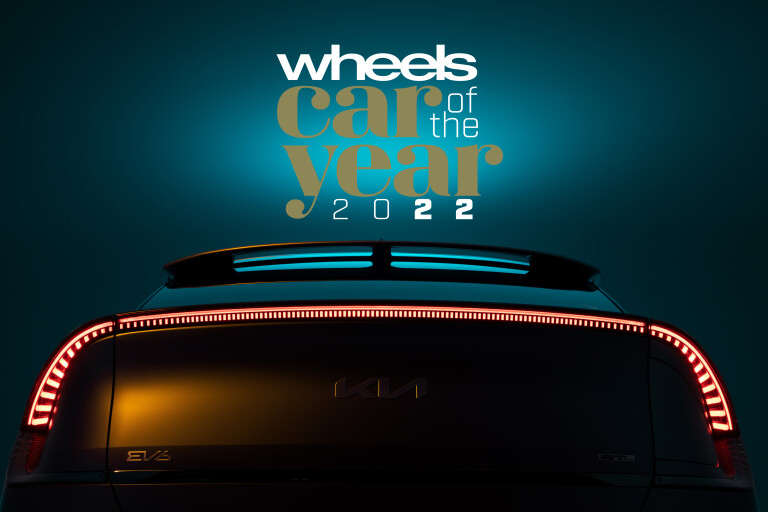
106
Interior comfort, space and storage
The ID.4 and 5 will be Australias first taste of Volkswagens ID models, hence this interior. Its familiar from the ID.3 below and the ID.Buzz above, with the companys famous scalable platform philosophy no more evident than in the screens and ergonomics of these cars.
Which isnt all rosy; a decision to pop almost all major controls within the touchscreen or on touch-sensitive pads does make it all a bit mind-boggling when you first climb aboard. There are just two window switches for instance, and youll have to tap a button to switch them between operating the front and rear windows.
Although this declutters the place nicely, it does give you something new to suss out. VW used to be the master of ergonomics, so its a bit odd that these IDs might discombobulate their drivers. The company has already announced that real buttons will make a triumphant return in future facelifts, so we might not have to spend long acclimatising to the ID.5s cabin quirks.

106
It's very well made, though, and all materials are high quality save for the door bins, which are cheap, almost sacrificial plastic, so at least you wont mind them getting scuffed.
The central 12-inch touchscreen is nicely high res (even with the absurd and distracting oversight of not illuminating the strip of climate controls at its base) and the small digital instrument gauge is neat and uncomplicated.
A big windscreen lends the interior an airy quality, one which continues rearwards, too.
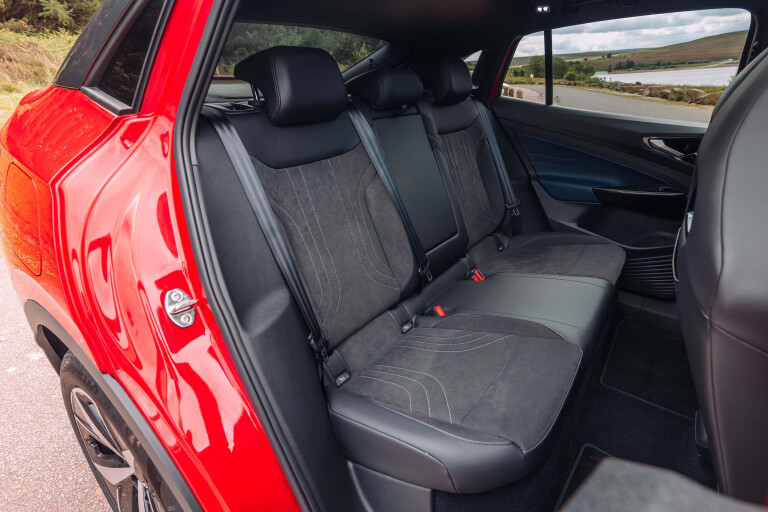
106
This is very habitable for a crossover coupe.
While rear visibility is inevitably an unhelpful sliver high waistlines and low rooflines rarely produce anything else together the rest of its hindquarters are impressive, with plenty of legroom and headroom for most adults and a window line sympathetic to letting a decent amount of light in.
Real pernickety stuff, well admit, but its curious how claustrophobic some of these cars can feel for those perched in the back. The ID.5 looks after them well, with a pair of USB-C ports the cherry on top of some very friendly hospitality.
Volkswagen ID.5 boot space
The boot in the VW ID.5 is marginally more commodious than an ID.4s with the seats up, at 549 litres, though slightly smaller with them folded, at 1561 litres.
Back to top
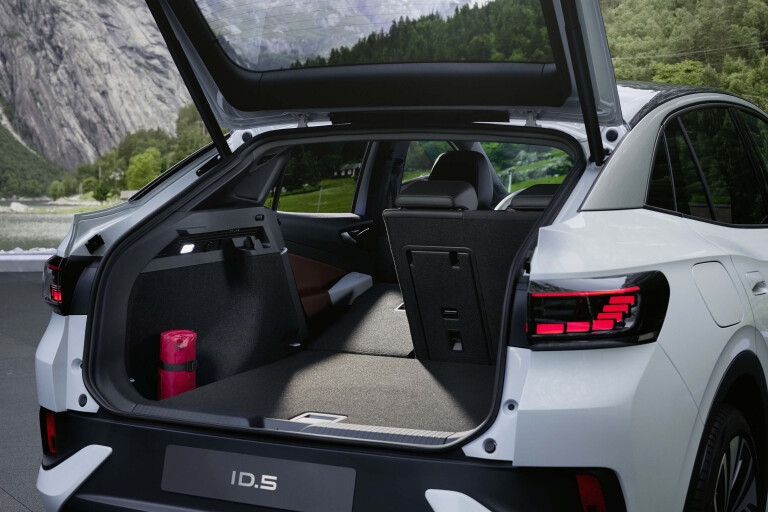
106
Whats it like to drive?
Given both rear-drive ID.5s share the same torque figure, they feel very similar in an urban environment, accelerating with the same modesty out of junctions and away from the lights there are no jaw-dropping EV theatrics when youve got a single motor in a 2.1-tonne car and handling with similar deftness.
While theres little in the way of outright fun here, the steering is light, quick and easily read and the benefits of its RWD platform are clear.
Its above 80km/h where the greater power-to-weight ratio of the Pro Performance comes to the fore. Its price premium ought to justify itself on sliproads and during overtakes, where theres just a touch more urgency to proceedings.
And this is us comparing the pair with just a driver on board fill your ID.5 with family and paraphernalia and the additional power will feel more starkly welcome.
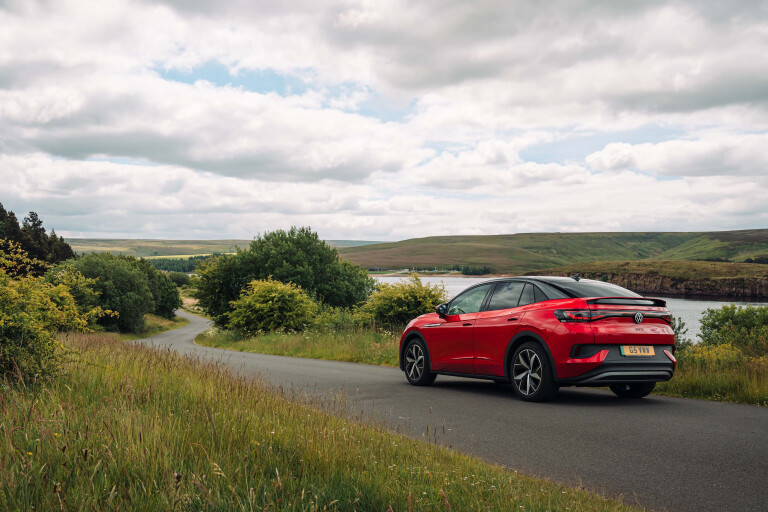
106
The GTX is a lot keener off the line and its acceleration never lets up.
If power is your chief concern, of course, theres the dual-motor GTX. Without pricing, we cant judge whether itll look good value, but in Europe, it costs 10 per cent more for whats basically 50 per cent more power. An appealing prospect, especially considering its range figure isnt dented too much.
Ride quality isnt notably firmer in the GTX than the fairly rigid variants below it 15-stage adaptive damping might even make it feel more habitable day-to-day and its larger breadth of performance is immediately evident. Its a lot keener off the line and its acceleration never lets up.
Although not gobsmacking like some electric cars (were looking at you, Tesla) but its much more in keeping with what weve come to expect from max torque at zero revs.

106
The GTX is easily the most charming version of the ID.5, though its not as fun to drive as its Tiguan R range-mate, for instance, while not having adjustable brake regen through steering wheel paddles as some EV rivals offer does give it a slightly aloof feel.
Its worth noting that GTX isnt a fully-fledged performance brand it sits a rung below where a GTI would, being more closely aligned with the GTD and GTE badges weve previously seen applied to the Golf.
Think of it in those terms and the ID.5 GTX ought to be a quietly satisfying proposition.
Back to top
How is its efficiency?
With all ID.5s packing a stocky 77kWh battery, range figures are good.
In European WLTP testing the Pro and Pro Performance offer up to 526km while the sportier GTX claims 505km, though each figure will incrementally fall if you start piling on options and fancier specs.
DC charging rates of up to 135kW are on offer (an improvement on the 125kW at the ID.4s launch), so youll be able to go from 0-80 per cent in around 30 minutes.
Using the cars native sat-nav can also help you plan a series of short stops at quick chargers on a long journey.
Back to top
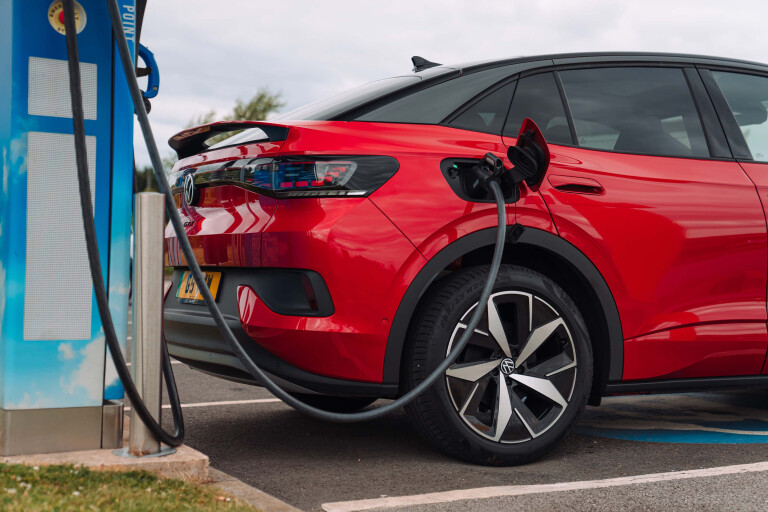
106
How safe is it?
Both the ID.4 and ID.5 are yet to be tested by ANCAP, though their five-star performances in the European NCAP tests promise much.
The ID.5 also hit the highest possible score for its assistance systems.
Forward collision avoidance and lane-keep assist are standard (the latter being devilishly hard to turn off if you dislike such things) while optional features include Travel Assist with swarm data, which helps keep the car neatly integrated within traffic on highways and assists the driver in changing lane safely.
The NCAP testers also highly rated how functional the ID.5s augmented reality head-up display is.
Back to top

106
VERDICT
This isnt the most exciting EV on sale, nor do you likely need it to be. VWs appeal has usually been its offer of a straight-laced, steadfast option among a sea of quirkier rivals. Which is exactly where the ID.5 sits among more aesthetically interesting or dynamically sharper rivals.
Its just a shame its more sensible approach isnt backed up by the quickest charging in the business. Choosing a Tesla, Kia or Hyundai will not only prove more convenient in that regard but is more likely to raise your pulse too.
That said, if you want your first EV to be an easily digested switch from internal combustion, the ID.5 is a strong bet.
Back to top

106
More EV stories to help you choose the best car for your needs
Score breakdown
Safety, value and features
Things we like
- Unaggressive looks buck the industry trend
- It makes EV life simple to comprehend
- GTX version is quick and largely fun
Not so much
- It doesnt charge as quickly as some rivals
- Nor is it as charming
- VWs dropped the ball with ergonomics
The successful ID family continues to grow: the new ID.5 is the first electric SUV coup from Volkswagen
The ID.5 is electric, sporty and elegant. Our premium SUV coup with all-electric drive marks another milestone in our ACCELERATE strategy, says Ralf Brandsttter, brand CEO. It offers locally carbon-neutral driving enjoyment for a discerning customer group. We are breaking into a completely new market segment with this model.
Elegant and dynamic design, outstanding aerodynamics, extensive range. The new ID.5 and the sporty ID.5 GTX with dual-motor all-wheel drive are the new, long-range top models in the ID. family. Like all ID. models, Volkswagens first e-SUV coup is based on the Volkswagen modular electric drive matrix (MEB).
The ID.5 is the body style of the future: aerodynamic, expressive, sporty and, thanks to MEB, with short overhangs, says Jozef Kaba, Head of Volkswagen Design. Thats how we have been able to ensure a spacious interior despite the dynamic roof line this simply wasnt possible before.
The new software generation 3.0 allows for over-the-air updates and activation of additional functions, so that the ID.5 can stay up-to-date for a long time. Innovative assistance systems such as Travel Assist with swarm data allow for an even more relaxed and predictive driving experience. The new optional Park Assist Plus with memory function will take care of personalised parking processes on request.
At 4599 mm long (ID.5 GTX: 4582 mm), the e-SUV coup from Volkswagen will launch in 2022 with three engine options. The ID.5 will be powered by an electric engine in the rear. The dual-motor all-wheel drive of the ID.5 GTX will be powered by an e-motor on the front and rear axles.
The electronic Vehicle Dynamics Manager is a groundbreaking development by Volkswagen, says Thomas Ulbrich, member of the Board of Management for Technical Development. We have networked it with other important control systems, and it is also integrated with the all-wheel control function. This brings an entirely new level of sporty driving pleasure, traction and driving safety.
All ID.5 engine types are powered by a large, long-range battery. A low drag coefficient of 0.26 (or 0.27 in the ID.5 GTX) increases efficiency and boosts the vehicles extensive range. This capability is further supported by the integrated spoiler in the wide-opening, aerodynamically shaped tailgate. Electric cooling air vents in the front of the vehicle open only when necessary, so as to ensure optimal air flow.
The new Volkswagen e-SUV coup projects independence and uniqueness from every angle. The characteristic LED technology, with light strips on the front (optional) and rear, unmistakably identifies the ID.5 as a member of the ID. family. Many features including the striking bumper, painted door panelling and new roof line set the e-SUV coup apart from the ID.4, which was named World Car of the year. The expressive coup design has a high recognition value. Its large air inlet and IQ.Light LED matrix headlights with intelligent high beams and 3D LED rear lights as standard give the ID.5 GTX an even more dynamic appearance. The Vehicle Dynamics Manager networks the drive and chassis control systems, while an optional adaptive DCC chassis ensures optimal driving dynamics. The ID.5 and ID.5 GTX coast in driving mode D and recuperate energy in mode B.
The new body style and lounge-like spatial concept highlight the innovative power of Volkswagen and its ID. family. Despite its coup-type shape, the ID.5 has just 12 mm less headroom in the back than the Volkswagen ID.4. The long 2766 mm wheelbase facilitates interior spatial conditions comparable to those of SUVs in higher vehicle classes. The luggage compartment volume is 549 litres, and the materials and manufacturing of the vehicle are of premium quality. Seat covering materials vary depending on the interior version. The optional Top Sports seats are distinguished by perforated ID logos at the top of the backrests.
The ultra-modern digital cockpit offers a new operating concept. The driver display and high-resolution multimedia system deliver strikingly brilliant visuals. An innovative augmented reality head-up display (optional) within the drivers field of vision presents additional information. The new ID. software 3.0 features various improvements including natural voice control (Hallo ID.) It is now learning-enabled and enables online access to information from the Cloud. For atmospheric interior lighting, the Ambient Lighting feature offers a choice of up to 30 colours. We Connect services provide the driver with real-time online traffic information, online map updates, information about charging stations, web radio and much more.
With Car2X communication, Volkswagen is taking safety to a whole new level. Data from compatible vehicles in the Volkswagen fleet and signals from infrastructure within a radius of up to 800 metres can be locally interpreted in a fraction of a second, enabling driver alerts about dangerous areas, accidents and stationary traffic. The ID. Light in the cockpit helps by providing visual warnings.
With the ID.5 and ID.5 GTX, Volkswagen is tapping into an entirely new market segment and thereby advancing its electric offensive in all vehicle classes in the framework of its ACCELERATE strategy. By 2030, at least 70 per cent of Volkswagens unit sales in Europe are expected to come from electric-only vehicles that is equivalent to more than one million vehicles. In North America and China, the goal is that electric vehicles will account for at least 50 per cent of unit sales. To achieve these goals, Volkswagen is launching at least one electric vehicle onto the market every year. The CO2 emissions per vehicle are set to decrease by up to 40 percent by as soon as 2030. On its Way to ZERO, the company is planning to become climate-neutral by 2050 at the latest.
The new ID.5 and the sporty premium ID.5 GTX with dual-motor all-wheel drive are manufactured at the Volkswagen plant in Zwickau and are carbon-neutral upon handover to the customer. When charged using 100 percent green energy, the vehicles are already virtually climate-neutral. With its We Charge charging system, Volkswagen offers the fastest-growing environmentally friendly system for convenient, networked and sustainable charging. The network has around 250,000 charging points across Europe. Using the standard Mode 3 cable, the e-SUV coup can also be charged with up to 11 kW of alternating current (AC), even when it is out and about. Charging performance can reach up to 135 kW as standard at a fast-charge station.


